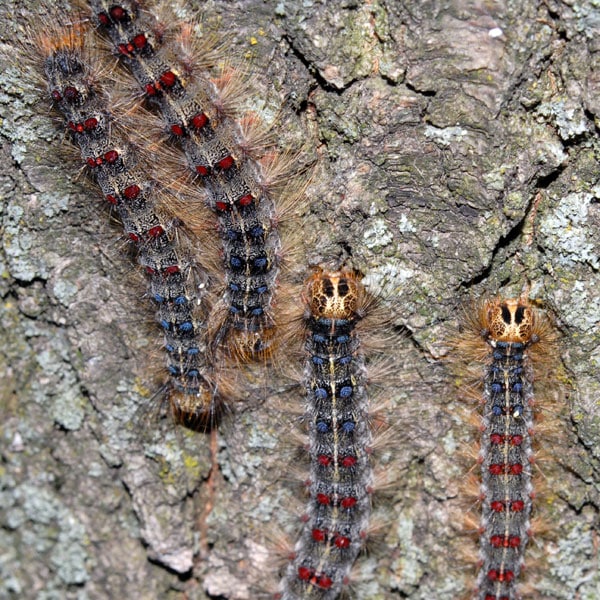Homeowners should scout now for invasive Gypsy Moth Caterpillars

Orleans County is bracing for another season of damage and defoliation from the invasive European Gypsy Moth, Lymantria dispar. The Diagnostic Helpline at the Orleans County Cornell Cooperative Extension received an extraordinary number of calls in 2020 regarding Gypsy Moth Caterpillars. It appears WNY is in the midst of a pretty substantial multi-year outbreak, and 2021 will likely see high numbers of Gypsy Moth Caterpillars in the Orleans County again. Typically, outbreaks will show high amounts of Gypsy Moths for two to four years, then the population will collapse due to natural causes such as predators, parasites, or disease. That is little comfort, however, for homeowners watching the caterpillars severely defoliate valued landscape plants or large portions of woodlots right now.
As of the last week of May, Gypsy Moth caterpillars had emerged from their egg masses and begun feeding. When they are small, they appear mostly black and hairy, and they disperse by “ballooning” – the caterpillars will send out a silk and float on the wind to other trees and shrubs to begin feeding. As the caterpillars feed, they molt several times – shedding their skin as they grow larger and changing appearance from early stages to more mature larval instars. The mature larvae will be dark in color, covered in hairs, and have pairs of orange and blue dots along the length of their body. Gypsy Moth caterpillars can grow to be over two inches long, and as they reach maturity, they can consume massive amounts of leaf tissue in a single day.
The preferred tree species for this invasive pest are oaks, willows, poplars, birch and apple trees, but they will feed on many other deciduous tree species as well as some conifers. Most healthy mature deciduous trees can withstand one season of defoliation – once the Gypsy Moth larvae finish feeding and pupate, the trees can usually send out a second flush of leaves mid-summer. Trees that have suffered complete or almost complete defoliation for two or three years in a row, or trees that are young or otherwise stressed may have a harder time recuperating from defoliation. Conifers can be killed from a single season of defoliation. DEC forester Garrett Koplun recommends regularly irrigating any landscape trees with significant defoliation. Keeping soil moisture levels even by deeply watering (to a depth of 12 to 18 inches) extending out to the dripline is the best thing homeowners can do to reduce stress on trees affected by Gypsy Moth Caterpillars.
For homeowners wanting to reduce the amount of defoliation and damage done by the caterpillars this year, timing is critical. Manual removal is an option, picking or scraping the caterpillars off of host plants into a bucket of soapy water and then discarding after they die. Use caution when touching the caterpillars as their hairs can cause an adverse skin reaction in some people. Manually removing caterpillars may not be practical, however, if there are massive amounts or caterpillars or if they are out of reach on taller landscape trees.
There are pesticide sprays available on the market registered for use against Gypsy Moth Caterpillars, but they are most effective when caterpillars are smaller than one inch long. It can also be difficult for homeowners to treat using pesticides if the caterpillars are high up in mature trees. As the Gypsy Moth life cycle progresses, homeowners are more and more limited in management options. More information about Gypsy Moth life cycles and links to management options can be found at the NYSIPM blog article from July 2020 “People are talking about Gypsy Moths,” https://blogs.cornell.edu/nysipm/2020/07/30/people-are-talking-about-gypsy-moths/.
Gypsy Moth Caterpillars can feed for up to six weeks each season, so homeowners are encouraged to check their trees regularly and to consider thresholds of tolerance and management choices now in order to better plan for later in the season.
For identification or more information on Gypsy Moths or other insects and diseases in the home landscape, contact Katie Oakes, Horticulture Educator with Orleans County CCE at 798-4265 ext. 125 or klo54@cornell.edu.
Provided information





